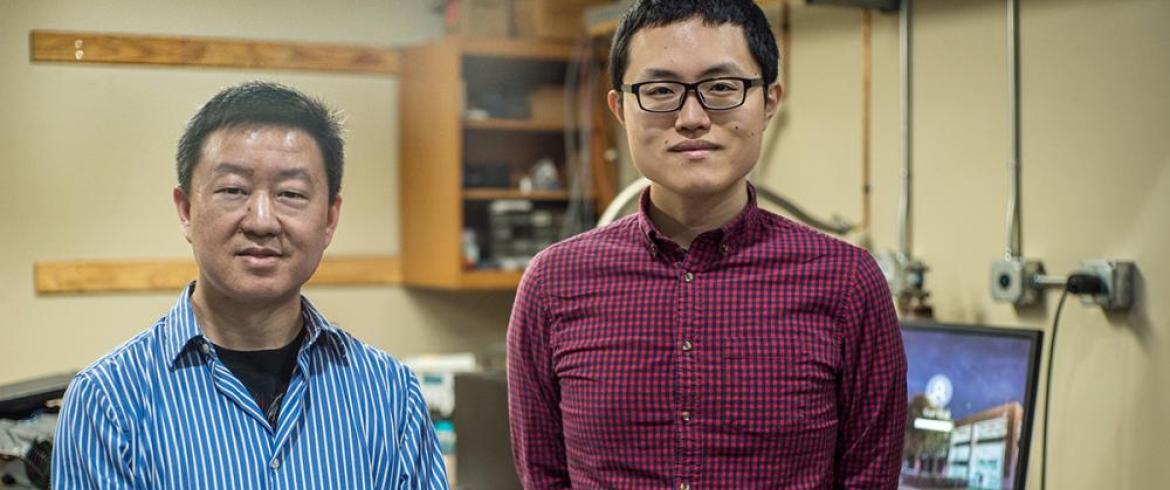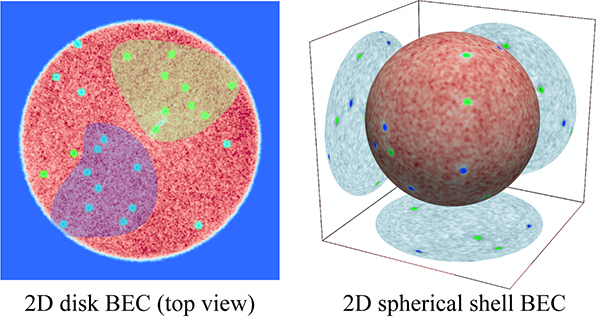
Wei Guo, associate professor in mechanical engineering and Toshiaki Kanai, a graduate research student working with Guo at the National High Magnetic Field Laboratory (Photo: S Bilenky)
Wei Guo and his team of researchers disproved a well-accepted theory of swirling motion in 2D superfluid turbulence
Engineering researchers at the FAMU-FSU College of Engineering and the National High Magnetic Field Laboratory revealed that a well-accepted explanation of the spontaneous formation of Onsager vortices in 2D superfluid turbulence is incorrect. Their findings are published recently in Physical Review Letters (PRL).
The significance of the work is far-reaching since it not only improves our understanding of vortex dynamics in many 2D superfluid systems but may also provide valuable implications to the atmospheric swirling motion on planets such as the Earth and Jupiter.
Nobel Laureate Lars Onsager proposed a simple theory in 1949 relating to our understanding of the swirling motion in turbulent 2D fluids. Onsager’s theory says when energy is added constantly into a 2D turbulent fluid with chaotic small swirls (formally called vortices), those swirls rotating in the same direction would cluster to form large-scale persistent swirls when the energy is sufficiently high. These clusters or large-scale swirls are known as “Onsager vortices.” Jupiter’s great red spot is a good example.

“Onsager’s theory requires energy to be added to the 2D fluid," Wei Guo, associate professor in mechanical engineering and lead investigator in the study, said. “However, recent publications in PRL revealed strikingly that in 2D Bose-Einstein Condensates (BECs), Onsager vortices can appear spontaneously without energy input.”
BEC is a state of matter where identical atoms or molecules are confined by a laser or magnetic trap and cooled to near absolute zero. The particles in the BEC state occupy the same quantum mechanical energy level and can exhibit superfluid behaviors, such as flowing without dissipation and rotating around tiny hollow tubes called vortex tubes. With an appropriate trap, a BEC can be confined to have a quasi-2D disk shape, i.e., with a small thickness but a large radius. The vortex tubes in a 2D BEC appear like tiny point swirls, which can serve as an ideal testbed for Onsager’s theory.
“A well-accepted explanation of the spontaneous appearance of Onsager vortices in 2D disk BECs is the evaporative heating mechanism,” Guo said. “This mechanism refers to the annihilation of pairs of vortices with opposite rotation.”
“As the vortices annihilate, the energy per vortex increases, which leads to the formation of Onsager vortices,” added Toshiaki Kanai, a graduate research student working with Guo at the National High Magnetic Field Laboratory.
However, in a numerical simulation performed by Kanai and Guo while studying the turbulent swirling motion in 2D, with BECs confined on the surface of a sphere, they found that Onsager vortices never formed despite the annihilations of the vortex pairs.
The researchers then conducted a systematic comparative study of the vortex dynamics in both disk BECs and spherical shell BECs.
“We finally figured out that the spontaneous formation of Onsager vortices is not due to the well-accepted evaporative heating mechanism,” Guo said. “The true mechanism is the exiting of the vortices from the 2D BEC boundary.”
The disk BEC has a circumference where the vortices can exit, while the spherical shell BEC does not have any boundaries. Therefore, Onsager vortices are observed only in the disk BECs but not in the spherical BEC shells, according to the researchers.
“Identifying the true mechanism for the spontaneous formation of Onsager vortices in 2D BECs represents a major progress in our understanding of 2D superfluid turbulence,” Guo said. “Our findings about the point vortices on a sphere may represent a conceptually interesting model of a planetary atmosphere, and these findings can be tested experimentally at NASA’s space laboratory.”
NASA has recently installed a cold atom laboratory at the International Space Station, which has made it feasible to produce BECs in spherical shell geometry. A future experimental study in zero gravity will help advance the knowledge in this area.
This research is funded by a three-year National Science Foundation grant (Grant # DMR-2100790).
RELATED ARTICLES
FAMU-FSU cryogenic researchers use the science of “cool” to advance particle accelerator development
Using 3D imaging technology to advance quantum fluid research
